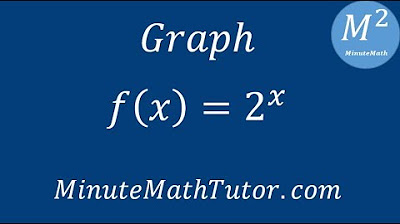How to find the domain and the range of a function given its graph (example) | Khan Academy
Summary
TLDRThe video transcript explains how to determine the domain and range of a function f(x) by analyzing its graph. The speaker walks through several examples, showing how to identify where the function is defined (domain) and what y-values it can take (range). For domain, they explain that f(x) is defined only within certain x-values, while for range, they discuss the possible y-values that f(x) can reach. The process involves understanding inequalities for both the x and y values, providing clarity through practical graph examples.
Takeaways
- 📉 The function f(x) is graphed, and we need to determine its domain.
- 🔢 The function starts being defined at x = -6, and f(-6) equals 5.
- 📏 The domain of the function is the set of x values from -6 to 7, inclusive.
- 📈 The function f(x) is defined for any x value that satisfies -6 ≤ x ≤ 7.
- 🔍 Another example shows that f(x) is not defined until x = -1, where f(-1) equals -5.
- 🧮 For the second example, the domain is -1 ≤ x ≤ 7.
- 🔢 The range of the function is determined by the set of possible y values.
- 📊 The lowest y value for f(x) is 0, and the highest is 8, giving a range of 0 ≤ f(x) ≤ 8.
- ✏️ A third example shows a domain of -2 ≤ x ≤ 5.
- 🔍 In each case, the function’s domain and range are determined based on where the function is defined and the set of corresponding y values.
Q & A
What is the domain of the function f(x) in the first example?
-The domain of the function is from x = -6 to x = 7, inclusive. This means the function is defined for all values of x where -6 ≤ x ≤ 7.
What does it mean when the function is defined between certain x-values?
-It means that for any x-value within the specified range, you can find a corresponding y-value (or f(x)). Outside this range, the function is not defined, meaning there is no corresponding y-value.
What is the value of f(x) when x = -6 in the first example?
-When x = -6, the value of f(x) is 5.
How do you determine if a function is defined for a specific x-value?
-You check the graph to see if there is a point corresponding to that x-value. If there is, the function is defined for that value; if not, the function is undefined for that x-value.
In the second example, what is the domain of f(x)?
-In the second example, the domain of f(x) is from x = -1 to x = 7, inclusive. This means the function is defined for all x-values where -1 ≤ x ≤ 7.
What is the range of the function f(x) in the third example?
-The range of the function is from 0 to 8, inclusive. This means the function takes on values of y (or f(x)) between 0 and 8, including these values.
How do you find the range of a function from its graph?
-To find the range, you look at the y-values that the function takes on across the entire domain. The lowest y-value is the minimum of the range, and the highest y-value is the maximum.
What is the significance of the y-values in the range of a function?
-The y-values in the range represent all possible outputs (f(x) values) that the function can produce based on the x-values in the domain.
In the final example, what is the domain of f(x)?
-The domain of the function in the final example is from x = -2 to x = 5, inclusive. This means the function is defined for all x-values between -2 and 5.
How does the domain differ from the range of a function?
-The domain represents all possible x-values for which the function is defined, while the range represents all possible y-values (f(x)) that the function can output.
Outlines

Esta sección está disponible solo para usuarios con suscripción. Por favor, mejora tu plan para acceder a esta parte.
Mejorar ahoraMindmap

Esta sección está disponible solo para usuarios con suscripción. Por favor, mejora tu plan para acceder a esta parte.
Mejorar ahoraKeywords

Esta sección está disponible solo para usuarios con suscripción. Por favor, mejora tu plan para acceder a esta parte.
Mejorar ahoraHighlights

Esta sección está disponible solo para usuarios con suscripción. Por favor, mejora tu plan para acceder a esta parte.
Mejorar ahoraTranscripts

Esta sección está disponible solo para usuarios con suscripción. Por favor, mejora tu plan para acceder a esta parte.
Mejorar ahoraVer Más Videos Relacionados

Restricting domain of trig function to make invertible | Trigonometry | Khan Academy

Relasi dan Fungsi Matematika Kelas 10 • Part 25: Soal Fungsi Rasional Bentuk 2 - Linear / Kuadrat

Graph f(x)=2^x

Trig functions grade 11 and 12: Determine Equation

Graph & illustrates Linear Function Find the Domain Range Table of values Intercepts & Slope Math 8

Relations and Functions | Algebra
5.0 / 5 (0 votes)
